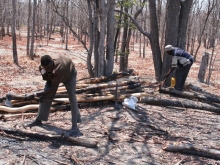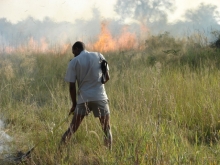Threats to the environment
Fire
While bush fires are a natural phenomena, effective fire management is important to prevent uncontrollable fires. Former management approaches centered on suppressing and extinguishing bushfires and creating firebreaks. However, these techniques allow the build-up of fuel (grass, leaves etc) and postpone bushfires to times when climatic conditions are very hot, dry and windy. Fires under these conditions cannot be contained and consequently reach disastrous proportions resulting in destruction with loss of life, property and the environment.
The Community Forests, Directorate of Forestry and local NGOs are now implementing a fire management strategy which utilises controlled burns in the early and mid dry season. Controlled burns in a patchwork mosaic have many benefits including: slowing down wildfires, reducing fire intensity, enhancing grazing, preventing damage to infrastructure and fences, reducing bush encroachment, opening up areas for wildlife and increasing habitat diversity. Forestry officials are also working closely with local communities to enhance awareness of appropriate fire management techniques.
Human wildlife conflict
In an area such as this, where people and wildlife co-exist, the potential for conflict between people and wildlife is high. Wildlife such as elephants can cause substantial damage to crops and infrastructure such as water pumps, as well as endangering human life, while predators such as crocodiles and lions pose a direct risk to humans and their livestock. However, without healthy wildlife populations, the potential for local people to generate benefits from wildlife and other natural resources - for example, from wildlife-based tourism - would be significantly reduced. Careful management is needed to enable communities to offset the costs local people incur by living with wildlife.
Poaching
Since controlling a surge in poaching in the late 1980s early 1990s Namibia, and specifically the Mudumu Landscape, has experienced insignificant levels of poaching. The changes in the Protected Areas and Wildlife Management policies that followed independence and the rapid growth of the community based natural resource management and conservancy programme within Namibia have contributed to the upward trends of most wildlife in the Mudumu Landscape.
Both national parks and conservancies within the landscape have active law enforcement programmes through the constant patrolling of areas by Ministry of Environment and Tourism staff and conservancy game guards. Coordination and integration of activities such as planning, monitoring and adaptive management is important at the landscape level and this approach between all partners in the landscape has the greatest potential in keeping the poaching level to the minimum.
Unsustainable utilisation of resources
Utilisation of the natural resources of the landscape is essential for the livelihoods of the communities living within the landscape but requires effective management to ensure sustainable use. Within the conservancies, utilisation of resources such as grasses for grazing and thatching, for example, is assessed through the Event Book system to ensure sustainability. Offtakes of game animals through trophy hunting and own-use hunting are determined by the Ministry of Environment and Tourism through a quota system based on the game monitoring systems in place.





